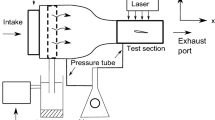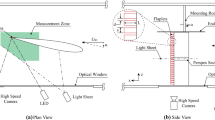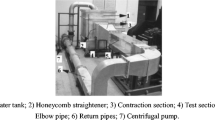Abstract
The unsteady low Reynolds number aerodynamics of flapping flight was investigated experimentally through flow visualization by suspended particle imagery and wall shear stress measurement from micro-array hot-film anemometry. In conjunction, a mechanism was developed to create a flapping motion with three degrees of freedom and adjustable flapping frequency. The flapping kinematics and wing shape were selected for dynamic similarity to a hummingbird during hovering flight. Flow visualization was used to validate the anemometry observations of leading edge vortex (LEV) characteristics and to investigate the necessity of spanwise flow in LEV stability. The shear sensors determined LEV characteristics throughout the translation section of the stroke period for various wing speeds. It was observed that a minimum frequency between 2 and 3.5 Hz is required for the formation and stabilization of a LEV. The vortex strength peaked around 30% of the flapping cycle (corresponding to just past the translation midpoint), which agrees with results from previous studies conducted by others. The shear sensors also indicated a mild growth in LEV size during translation sections of the wing’s motion. This growth magnitude was nearly constant through a range of operating frequencies.




















Similar content being viewed by others
References
Altshuler DL, Dudley R, Ellington CP (2004) Aerodynamic forces of revolving hummingbird wings and wing models. J Zool Proc Zool Soc Lond 264:327–332
Birch JM, Dickinson MH (2001) Spanwise flow and the attachment of the leading-edge vortex on insect wings. Nature 412:729–733
Birch JM, Dickson WB, Dickinson MH (2004) Force production and flow structure of the leading edge vortex on flapping wings at high and low Reynolds numbers. J Exp Biol 207:1063–1072
Bomphrey RJ, Lawson NJ, Harding NJ, Taylor GK, Thomas ALR (2005) The aerodynamics of Manduca sexta: digital particle image velocimetry analysis of the leading-edge vortex. J Exp Biol 208:1079–1094
Dickinson MH, Götz KG (1993) Unsteady aerodynamic performance of model wings at low Reynolds numbers. J Exp Biol 174:45–64
Dickinson MH, Lehmann FO, Sane SP (1999) Wing rotation and the aerodynamic basis of insect flight. Science 284:1954–1960
Maxworthy T (1979) Experiments on the Weis-Fogh mechanism of lift generation by insects in hovering flight. Part 1. Dynamics of the ‘fling’. J Fluid Mech 93:47–63
Saffman PG, Sheffield JS (1977) Flow over a wing with an attached free vortex. Stud Appl Math 57:107–117
Saharon D, Luttges MW (1988) Visualization of unsteady separated flow produces by mechanically driven dragonfly wing kinematics model. AIAA J 88-0569:1–23
Sahin M, Hall J, Mohseni K (2008) Direct numerical simulation of separated low-reynolds number flows around an Eppler 387 Airfoil. 46th AIAA Aerospace Sciences Meeting and Exhibit. Reno, NV, 7–10 Jan 2008
Sane SP (2003) The aerodynamics of insect flight. J Exp Biol 206:4149–4208
Sane SP, Dickinson MH (2001) The control of flight force by a flapping wing: lift and drag production. J Exp Biol 204:2607–2626
Shyy W, Lian Y, Tang J, Viieru D, Liu H (2008) Aerodynamics of low Reynolds number flyers. Cambridge University Press, New York
Srygley RB, Thomas LR (2002) Unconventional lift-generating mechanisms in free-flying butterflies. Nature 420:660–664
Tavoularis S (2005) Measurement in fluid mechanics. Cambridge University Press, New York
Thomas LR, Taylor GK, Srygley RB, Nudds RL, Bomphrey RJ (2004) Dragonfly flight: free-flight and tethered flow visualizations reveal a diverse array of unsteady lift-generating mechanisms, controlled primarily via angle of attack. J Exp Biol 207:4299–4323
Tobalske BW, Warrick DR, Clark CJ, Powers DR, Hedrick TL, Hyder GA, Biewener AA (2007) Three-dimensional kinematics of hummingbird flight. J Exp Biol 210:2368–2382
Usherwood JR, Ellington CP (2002) The aerodynamics of revolving wings (I. Model hawkmoth wings). J Exp Biol 205:1547–1564
van den Berg C, Ellington CP (1997a) The vortex wake of a `hovering’ model hawkmoth. Phil Trans R Soc Lond B 352:317–328
van den Berg C, Ellington CP (1997b) The three-dimensional leading-edge vortex of a `hovering’ model hawkmoth. Phil Trans R Soc Lond B 352:329–340
Vanier B (2008) Detection of aerodynamic flow structures during hummingbird like flapping motion using hot film anemometry tavoularix. Master’s Thesis. University of Colorado at Boulder
Wang ZJ, Birch JM, Dickinson MH (2004) Unsteady forces and flows in a low Reynolds number hovering flight: two-dimensional computations vs. robotic wing experiments. J Exp Biol 207:449–460
Warrick DR, Tobalske BW, Powers DR (2005) Aerodynamics of the hovering hummingbird. Nature 435:1094–1097
Weis-Fogh T (1973) Quick estimates of flight fitness in hovering animals, including novel mechanisms for lift production. J Exp Biol 59:169–230
Author information
Authors and Affiliations
Corresponding author
Rights and permissions
About this article
Cite this article
Swanton, E.W.M., Vanier, B.A. & Mohseni, K. Flow visualization and wall shear stress of a flapping model hummingbird wing. Exp Fluids 49, 657–671 (2010). https://doi.org/10.1007/s00348-010-0832-1
Received:
Revised:
Accepted:
Published:
Issue Date:
DOI: https://doi.org/10.1007/s00348-010-0832-1




